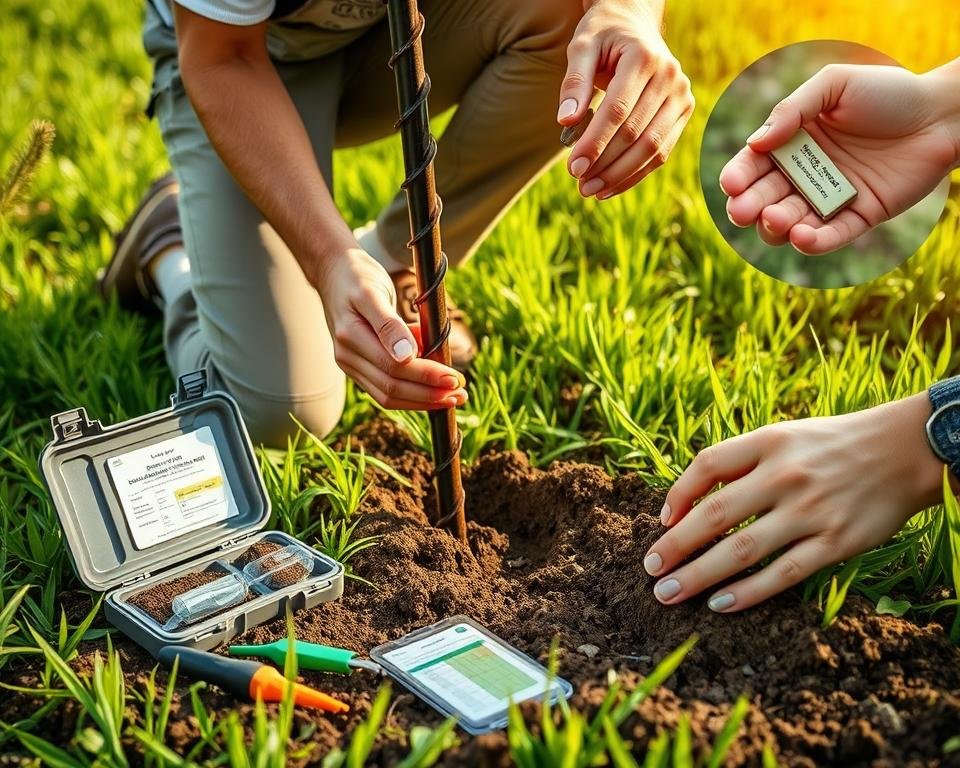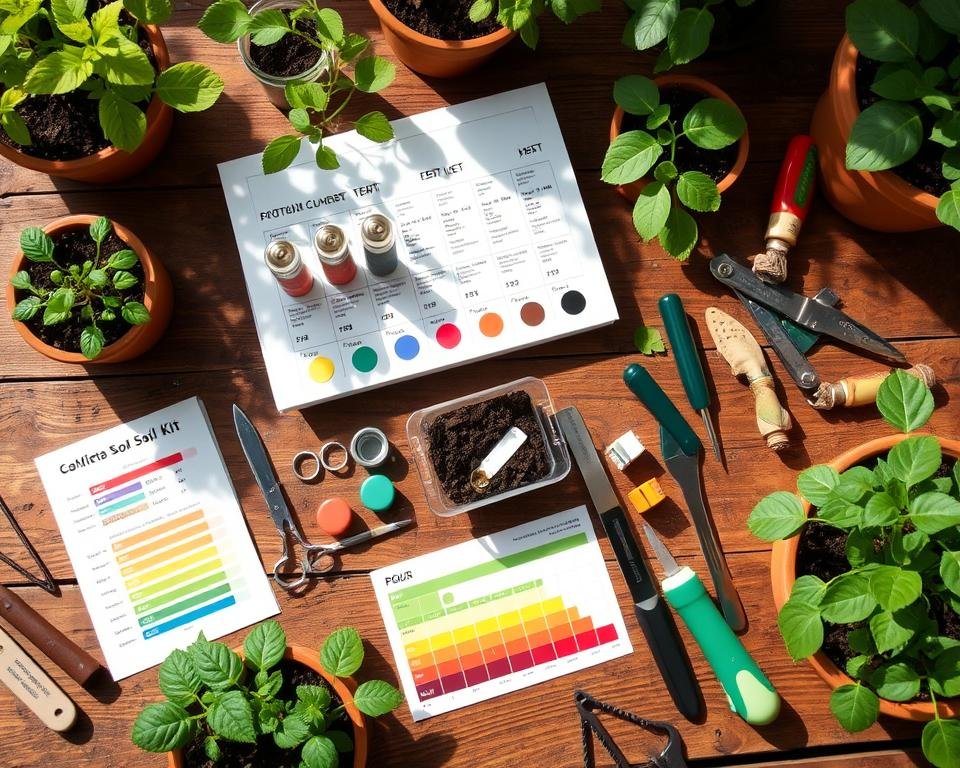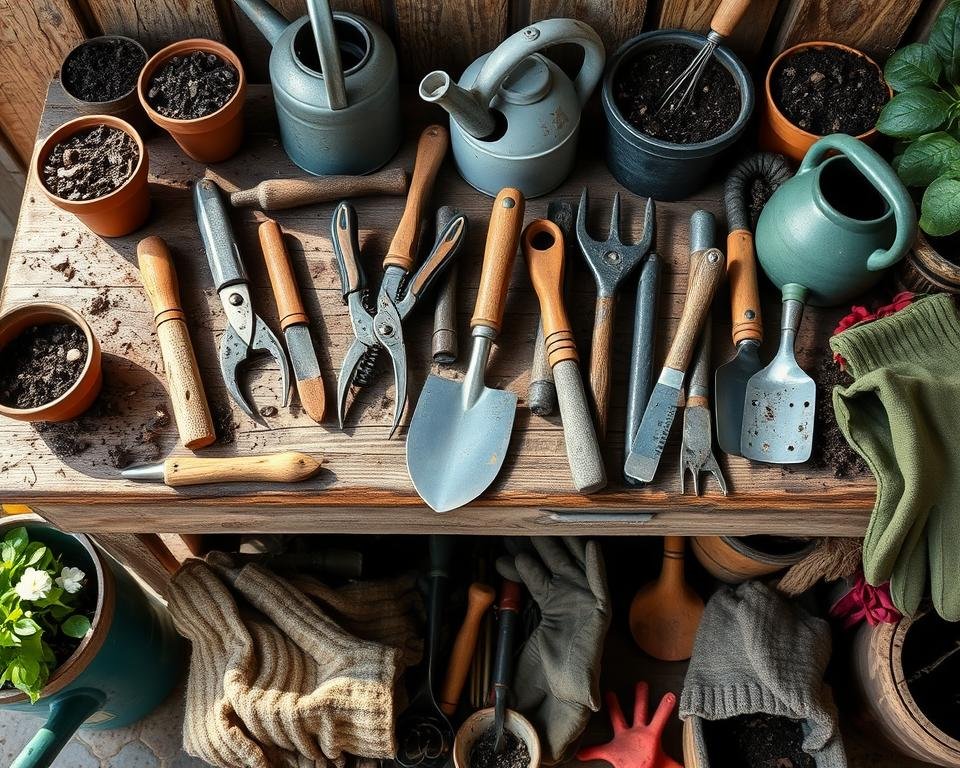Want to unlock your garden or lawn’s full potential? The secret is in knowing your soil’s makeup. Soil test kits are a simple yet powerful tool to find out what your soil needs. This guide will show you how to use these kits to get the best results for your outdoor spaces.
Learn how to read soil analysis and take the right samples. This guide will give you the skills to use soil test kits well. You’ll discover the perks of regular testing, the various kits out there, and how to get precise results. With this guide, you’ll be ready to create the healthiest and most vibrant outdoor areas.
The Importance of Soil Testing
Keeping your garden, lawn, or farm healthy starts with knowing your soil. Regular soil tests are key. They show you the soil’s pH, nutrients, and quality. This info helps you choose the right soil care for better plant growth.
Understanding Soil Composition
Soil is a mix of minerals, organic stuff, and life forms. Together, they decide how fertile and good for plants your soil is. The soil pH affects how plants get nutrients. Testing your soil often helps you fix any problems early.
Benefits of Regular Soil Analysis
- Find out if your garden soil health, lawn soil health, or farm soil health needs help
- Use the right fertilizers and soil fixes to boost plant growth
- Keep track of soil changes and manage them well
- Keep your soil healthy for years, helping plants grow strong and your ecosystem thrive
Knowing why soil testing matters and checking your soil often helps. You can then make smart choices for your plants, in your garden, lawn, or farm.
Types of Soil Test Kits
There are many soil test kits to help you understand your soil’s health. You can choose from simple at-home soil testing to detailed professional soil testing. The right kit depends on how much detail you need and your soil goals.
Soil test kits like pH testing kits show if your soil is too acidic or alkaline. This is key for picking the right plants and fertilizers. Nutrient measurement kits also check for important minerals like nitrogen and potassium.
For a deeper look, DIY soil analysis kits from top soil test kit brands offer more tests. They can measure soil texture, organic matter, and even contaminants. These kits help gardeners, landscapers, and farmers improve their soil and plant health.
| Soil Test Kit Type | Key Features | Suitable for |
|---|---|---|
| pH Testing Kits | Measure soil acidity/alkalinity | Gardeners, landscapers, farmers |
| Nutrient Measurement Kits | Assess levels of essential minerals | Gardeners, landscapers, farmers |
| Comprehensive Soil Test Kits | Analyze soil texture, organic matter, contaminants | Gardeners, landscapers, farmers, researchers |
Whether you’re a home gardener or a professional landscaper, the right soil test kit is crucial. It gives you the insights you need to succeed.
Preparing for Soil Sampling
Getting accurate soil test results starts with the right soil sampling techniques. It’s important to be careful and detailed when collecting soil samples. We’ll show you how to pick the best spots and the right ways to collect your samples.
Selecting Sampling Areas
When testing soil, it’s better to have more samples. Taking samples from different places in your garden or field helps understand your soil better. Think about these points when choosing where to take your samples:
- Look for areas with different soil types, textures, or plants.
- Don’t take samples near the edges of your property. These areas might not show the true soil conditions.
- If your area is big, break it into smaller parts. Then, take samples from each section.
Proper Sampling Techniques
After picking your sampling spots, it’s time to collect the soil. Here are the best ways to do it:
- Use a clean, stainless steel or plastic tool to get your samples.
- Dig to 6-12 inches deep. Then, take a small amount of soil from each spot.
- Mix the soil samples in a clean bucket. This creates a mix that shows the overall soil condition.
- Wrap the mix in a clean bag. Label it with where you got it, how deep, and any other important details.
By following these steps, you’ll get soil test results that really show what your soil is like. This helps you make smart choices to improve your soil’s health and fertility.

Soil Test Kits: A Closer Look
Keeping your garden or lawn lush and thriving starts with knowing your soil. Soil test kits are handy for checking your soil’s nutrients and pH levels. We’ll explore pH testing kits and nutrient measurement kits in this section.
pH Testing Kits
Soil pH is key for plant nutrient availability. pH testing kits help you quickly see if your soil is too acidic or alkaline. They use colors or digital displays to show your soil’s pH level.
Knowing your plants’ ideal pH helps you adjust your soil. This ensures the best growing conditions for your plants.
Nutrient Measurement Kits
Nutrient measurement kits go beyond pH testing. They show you nitrogen, phosphorus, and potassium levels. These kits use different methods to measure these nutrients.
With this info, you can adjust your fertilizers. This ensures your plants get the nutrients they need for growth and health.
When picking a soil test kit, look at soil test kit features, soil test kit accuracy, and soil test kit brands. A good kit gives you accurate soil pH testing and soil nutrient testing. This helps you care for your soil better.

Understanding Soil Test Results
Interpreting your soil test results is key to knowing your soil’s health. These results show pH levels, nutrient amounts, and any imbalances. By analyzing this info, you can plan to improve your soil’s health. This ensures your garden, lawn, or farm can reach its best.
First, look at the pH levels. The pH scale is from 0 to 14, with 7 being neutral. Most plants do well in slightly acidic to slightly alkaline soil, between 6.0 and 7.5 pH. If your soil’s pH is off, you might need to add lime or sulfur to adjust it.
Then, examine the nutrient levels. The report will show the amounts of nitrogen, phosphorus, and potassium, plus micronutrients like iron and calcium. If any nutrients are low, you can add specific amendments to fix it and boost soil health.
| Nutrient | Deficiency Symptoms | Recommended Amendments |
|---|---|---|
| Nitrogen (N) | Yellowing leaves, stunted growth | Organic matter, compost, or nitrogen-rich fertilizers |
| Phosphorus (P) | Delayed maturity, purple or reddish leaves | Bone meal, rock phosphate, or phosphorus-rich fertilizers |
| Potassium (K) | Scorched leaf edges, weak stems | Potassium sulfate, wood ash, or potassium-rich fertilizers |
By understanding your soil test results and using the right amendments, you can greatly improve your soil’s health. This will help your plants thrive and lead to a bountiful harvest.
Soil Test Kits: Tips and Best Practices
To get the most out of your soil test kits, follow some key tips. Knowing when to test your soil and how to store your kit is crucial. This section will guide you to get accurate results for better plant growth and soil health.
Timing Your Soil Tests
When you test your soil matters a lot. Experts say test it at least once a year. The best times are in the fall or early spring when the ground is not frozen. This way, you can adjust your soil before the growing season starts.
Maintaining Your Soil Test Kit
Keeping your soil test kit in good shape is vital for accurate results. Store it in a cool, dry place. Make sure all parts are clean and in working order. Replace any damaged parts right away to keep your kit reliable.
Interpreting Your Soil Test Results
Understanding your soil test results is key to a great garden or landscape. Take the time to review them carefully. Then, talk to local experts or resources to figure out the best steps for your soil.
Adjusting Your Soil Accordingly
After knowing your soil’s needs, it’s time to act. Follow the advice from your test results. This might mean adding organic matter or adjusting pH levels. Keep a close eye on how your soil responds.
By using your soil test kits wisely, you can keep your soil healthy. This ensures your plants will thrive. Remember, regular soil testing is essential for a great garden or landscape.
Conclusion
Soil test kits are a powerful tool for your garden, lawn, or farm. They help you understand your soil’s composition and nutrient levels. This knowledge lets you make smart choices about amendments and irrigation.
This guide has given you the tools to use soil test kits well. You now know how to read the results and improve your soil’s health. You’ve learned about the importance of soil testing and the different types of kits.
Start using soil testing to transform your outdoor space. By focusing on soil health, you’ll enjoy a beautiful and productive land. You’ll also help the environment. Soil test kits are the first step to a lush and vibrant landscape.
FAQ
What is the purpose of using soil test kits?
Soil test kits help you understand your soil’s health. They show you the pH levels and nutrient amounts. This info helps you choose the right amendments for better plant growth and soil quality.
What types of soil test kits are available?
You can find many types of soil test kits. There are basic pH kits, nutrient analysis kits, and professional equipment. Choose one based on your needs and how detailed you want the results to be.
How do I properly collect a soil sample for testing?
Getting a good soil sample is key for accurate results. Make sure to pick representative areas and follow the depth and packaging instructions from the kit.
How do I interpret the results of my soil test?
Understanding your soil test results is easy once you know what they mean. You’ll see pH levels, nutrient amounts, and advice on how to fix any issues.
How often should I test my soil?
Testing frequency depends on your plants, soil amendments, and soil health. Generally, test every 2-3 years to keep track of changes and make adjustments.
What are the best soil test kit brands on the market?
Top brands include Luster Leaf, Kelway, Rapitest, and Soil Savvy. They offer various kits to fit your needs and budget.
Can I use a soil test kit to measure soil nutrients?
Yes, many kits can measure nutrients like nitrogen, phosphorus, and potassium. This info helps you plan fertilization to fix nutrient gaps.
How do I store and maintain my soil test kit?
Keep your kit in a cool, dry place to ensure accurate results. Follow the manufacturer’s storage tips and replace parts as needed.

